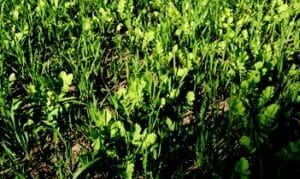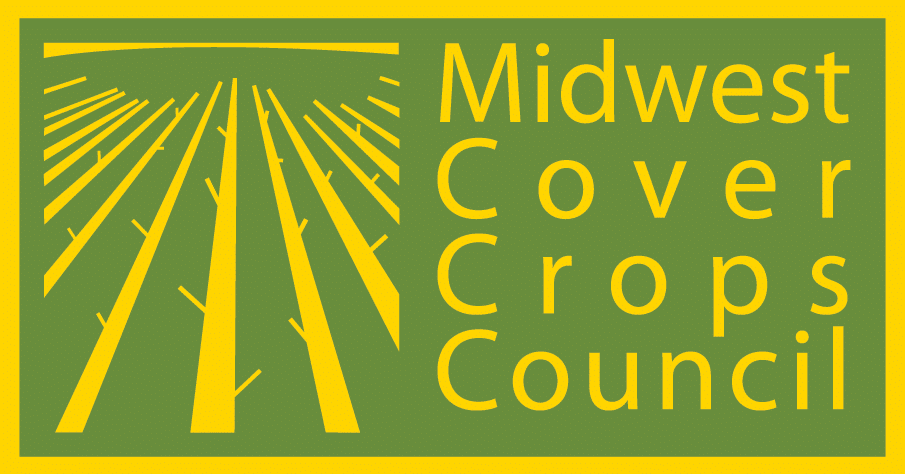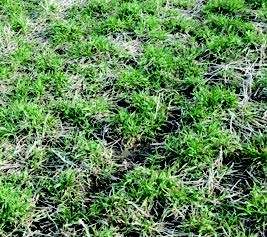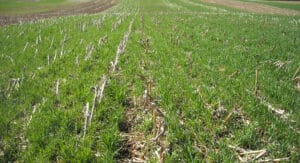Midwest Cover Crops Council (MCCC-111)
Michigan State Extension (CC-05)
This publication is intended to provide a starting point for farmers who are new to growing cover crops. With experience, farmers may fine-tune the use of cover crops for their systems.
Introduction
The following recipe provides an introductory approach to integrating a cover crop into a wheat rotation with soybean or corn. Planting oat and radish cover crops after wheat (see Figure 1) and ahead of a soybean or corn cash crop is an easy way to introduce cover crops into your rotation because these cover crops both winterkill and add important diversity to agricultural fields.

Planning and Preparation
- Planning—Educate yourself. Start small. Be timely. Prioritize management based on your purpose and objectives.
- Wheat variety and planting—No modifications to wheat variety and planting are required for the successful use of cover crops after wheat harvest.
- Residual wheat herbicides—Oats and radish are tolerant of most wheat residual herbicides, and few restrictions apply unless grazing is being considered. Oats and radish may be sensitive to Osprey® and PowerFlex®, and while data is limited, possible injury may result. See Weed Control Guide for Field Crops (in Resources section) for more details.
- Seed purchase—Order cover crop seed early. Named varieties generally perform more predictably and can produce substantially more growth than variety not stated (VNS) seed but are more expensive. VNS seed may be a good option when purchased from a reputable dealer if it has been cleaned, tested for germination, and has a seed tag. For cover crop radishes (daikon type), be sure to purchase a single variety from a reputable seed dealer since mixed varieties may have unpredictable emergence or immediately flower and produce seed rather than producing the desired large amounts of biomass and roots.
Summer/Fall Work
- Wheat harvest—Harvest wheat at the normal time in fields where a mix of oats and radish will be planted. If residue levels are high, consider removing straw or using light tillage to improve seed-to-soil contact.
- Timing of planting—Plant oats and radish any time in August after wheat harvest. Planting a cool-season annual, such as radish, prior to August is not recommended as it may result in flowering and seed production instead of quick coverage and biomass accumulation, which is the desired goal for this cover crop. Use the Cover Crop Selector Tool (in Resources section) for precise seeding dates for your county because both proximity to the Great Lakes and latitude influence planting dates.
- Planting method—Drill to a depth of 0.50–0.75 inch or broadcast with light incorporation. Note that disturbance of soil, if any, should be light since excessive disturbance of wheat stubble may negate any benefit of the cover crop. See Recommended Cover Crop Seeding Methods and Tools (in Resources section) for more details.
- Seeding rate in oats/radish mix—Mix seeds prior to planting at the following rates. Drilled: oats, 30–60 lbs./acre; radish, 2–3 lbs./acre. Broadcast: oats, 35–65 lbs./acre; radish, 3–4 lbs./acre. See Cover Crop Choices Following Winter Wheat (in Resources section) for more information.
- Tillage or no-tillage—To allow for adequate cover crop growth, it is best if no full-width tillage takes place until oats and radish have been killed by freezing temperatures. If tillage is used, it is usually better to wait until spring in order to maintain surface cover to prevent erosion.
- Fertility or liming—If applying P, K, lime, or manure, complete the application and incorporation prior to seeding or apply to the growing oats and radish before the ground freezes. If injecting manure, low-disturbance injectors are available that will minimize damage to oats and radish. Surface application of liquid manure on top of the cover crop is not recommended. Surface broadcast of dry manure or litter should be done prior to seeding, but 4 tons or less can be applied to growing oats and radish with minimal damage provided it is evenly distributed. See the manure management publication (in Resources section) for more information on generally accepted practices for manure management and utilization.

Spring Work
- Starter fertilizer—No modifications to your typical fertilization program are required for planting soybean or corn after oats and radish use.
- Termination—Oats and radish should both terminate by winterkill. However, mild winters and good snow cover sometimes allow overwintering of radish. If this occurs, radish is easily terminated with typical pre-plant herbicide applications.
- Soybean or corn planting—It is usually best to no-till plant cash crops into the dead/dry or standing cover crop. Almost all modern planters and drills are fully capable of planting soybean or corn into an oat and radish cover crop. Check planting depth and seed furrow closure shortly after beginning to plant into the cover crop residue (see Figure 2) as usually some adjustments are needed.
- Scouting—After soybean or corn planting, scout for crop emergence and population. Additionally, scout for weeds since cover crop residue can often delay emergence of annual weeds, which may delay the application of post-emergence herbicides.
Resources
Cover Crop Selector Tool —available from Midwest Cover Crops Council
Cover Crop Choices Following Winter Wheat (Michigan State University Extension)
Weed Control Guide for Field Crops (Michigan State University Extension Bulletin E0434)
Cover Crop Termination (Michigan State University Extension publication CC-01)
Recommended Cover Crop Seeding Methods and Tools (Agronomy Technical Note)— available from USDA–Natural Resources Conservation Service
Generally Accepted Agricultural and Management Practices for Manure Management and Utilization—available from the Michigan Department of Agriculture and Rural Development
Authors
Dean Baas, Michigan State University Extension (MSUE); Christina Curell, MSUE; Paul Gross, MSUE; Monica Jean, MSUE; Philip Kaatz, MSUE; and Elizabeth H. Schultheis, MSU (Note: This publication was adapted with consent from MCCC under a joint project to produce customized introductory guidance about cover crops for all member states/provinces.)
Reviewers and Contributors
Jerry Grigar, USDA–Natural Resources Conservation Service; Erin Hill, MSU; Eileen J. Kladivko, Purdue University; Anna L. Morrow, Midwest Cover Crops Council; Sieg Snapp, MSU
The Midwest Cover Crops Council (www.https://www.midwestcovercrops.org) aims to facilitate widespread adoption of cover crops throughout the Midwest by providing educational/outreach resources and programs, conducting new research, and communicating about cover crops to the public.
Funding for this project was provided by McKnight Foundation.
August 2019
The U.S. Department of Agriculture (USDA) prohibits discrimination in all its programs and activities on the basis of race, color, national origin, age, disability, and where applicable, sex, marital status, familial status, parental status, religion, sexual orientation, genetic information, political beliefs, reprisal, or because all or a part of an individual’s income is derived from any public assistance program. (Not all prohibited bases apply to all programs.) Persons with disabilities who require alternative means for communication of program information (Braille, large print, audiotape, etc.) should contact USDA’s TARGET Center at (202) 720-2600 (voice and TDD). To file a complaint of discrimination write to USDA, Director, Office of Civil Rights, 1400 Independence Avenue, S.W., Washington, D.C. 20250-9410 or call (800) 795-3272 (voice) or (202) 720-6382 (TDD). USDA is an equal opportunity provider and employer. ©2019 by MCCC. All rights reserved.



